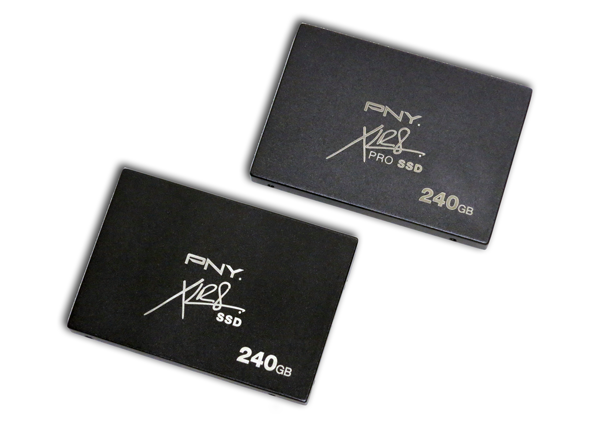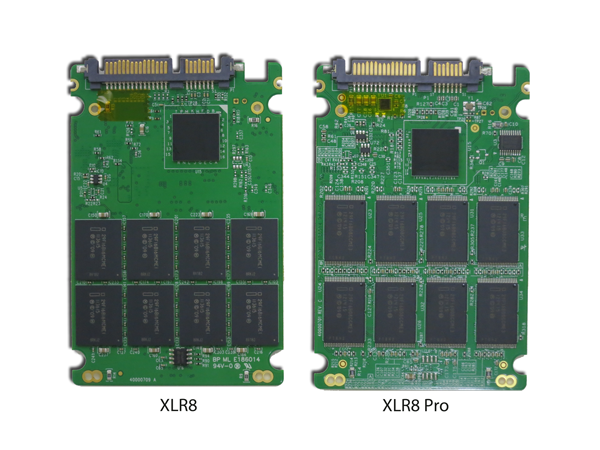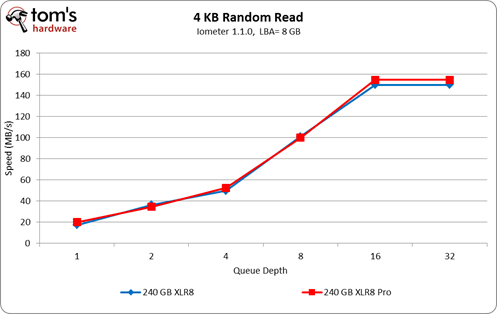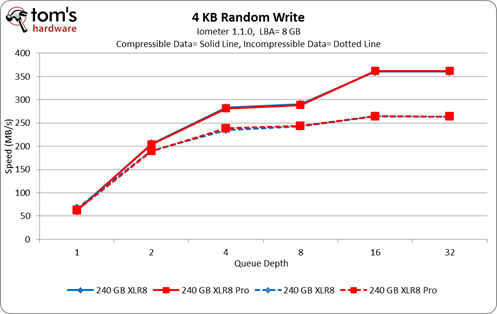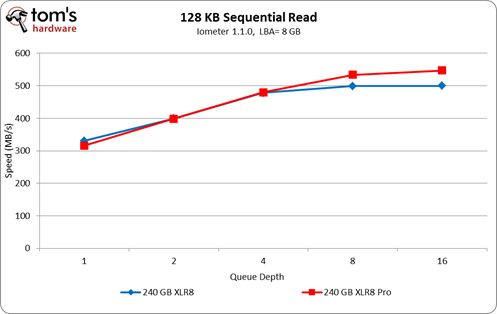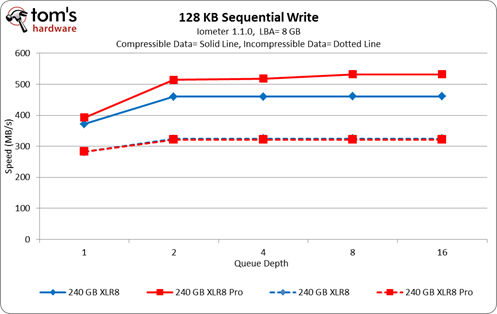Time To Upgrade: 10 SSDs Between 240 And 256 GB, Rounded Up
Over the past year, we've seen the cost per gigabyte of solid-state storage drop in a major way. Once upon a time, we shopped for affordable 60 and 80 GB drives. Now we really want 256 GB drives in our desktops. Meet the last 10 models to land in our lab.
PNY XLR8 Pro And XLR8
PNY is another vendor recognized for its history in the memory market, and now competing in the SSD space as one of SandForce's partners. Borrowing from the XLR8 brand it applies to its enthusiast-class DDR3 modules, the company clearly wants to align itself with the high-end.
Differentiation is achieved first by dividing its portfolio up between enterprise (Prevail) and consumer (XLR8) brands. Then, PNY splits each again. On the desktop side, we end up with the XLR8 and XLR8 Pro families. Both utilize 25 nm synchronous NAND from IMFT. Presumably, PNY arms its Pro drive with a more aggressive firmware able to boost sequential reads and writes, since its specifications indicate better performance.
Their bundles similarly include simple SATA cables. However, the XLR8 is only backed by three-year warranty coverage, while the XLR8 Pro's protection can be extended to five years simply by registering the drive.
It's a very good thing that PNY offers extra warranty coverage on the XLR8 Pro, since, in our testing, performance matches up with the XLR8 almost exactly in 4 KB random reads, 4 KB random writes, and 128 KB sequential reads.
Ramping up to a queue depth of 16 does see the XLR8 Pro take a small read in sequential reads (somewhere around 25 MB/s). Writing compressible data sequentially also favors the Pro model. But the end result isn't quite as pronounced as each drives spec sheet might have indicated, especially since workloads that apply high queue depths are very rare on the desktop.
In the context of this review, the difference between XLR8 and XLR8 Pro doesn't matter much. The 240 GB Pro model doesn't seem to be readily available. But what about the 120 GB versions, which can be found pretty easily? With $25 separating them, make your choice based on the importance of five-year warranty coverage versus three, not on a promised performance gain.
Get Tom's Hardware's best news and in-depth reviews, straight to your inbox.
-
mayankleoboy1 get the cheapest, biggest you possibly can. Benchmarks exaggerate the difference between SSD's.Reply -
A Bad Day I agree. Unless if you're buying a glorified USB stick (there is a 128 GB stick) or an SSD with an OC'ed processor, the main factor that consumers should be concerned about is price per gigabyte.Reply -
A Bad Day EDIT: And reliability.Reply
"In order to install a new firmware that significantly boost performance and stability, you must backup all of your data because it will be wiped." -
Tanquen Yea, it’s getting a little out of hand. For 90% of the things 90% of people do on their PC, 200MBs+ read and write speeds just don’t mean much. There are too many other bottle necks going on. I messed around with a RAM drive using most of my 64GB of RAM and the read and write speeds are fun to test (4000MBs or so) but games and VMware sessions I launched from the RAM disc saw no noticeable improvement in launch times or anything else. Same goes for my 830 SSD drive. It’s fast but games and software I use for SCADA development just don’t see any real benefit. They are cool if you want to open 10 sessions of MS Word and 15 Internet Explorer and a bunch of other stuff at the same time but if you just open one instance of Excel and use it and the Photo Shop and use it and then a web browser and use it, you’ll never really see the difference. You have to benchmark it or have two PCs setting right next to each other to see that something started or saved a split second faster.Reply
At least with my 64GB of RAM and actually get 64GB of RAM unlike HDs and SSDs.
-
tomfreak unless the sandforce drive is priced a lot cheaper than the similar capacity non-sandforce SDD. I always choose the non-sandforce SSD. 16GB is a big deal in SSD.Reply -
stoogie until theres affordable 512gb ssd's then i wont get 1, my c drive is 360gb~ and i have 11tbReply -
sna TanquenYea, it’s getting a little out of hand. For 90% of the things 90% of people do on their PC, 200MBs+ read and write speeds just don’t mean much. There are too many other bottle necks going on. I messed around with a RAM drive using most of my 64GB of RAM and the read and write speeds are fun to test (4000MBs or so) but games and VMware sessions I launched from the RAM disc saw no noticeable improvement in launch times or anything else. Same goes for my 830 SSD drive. It’s fast but games and software I use for SCADA development just don’t see any real benefit. They are cool if you want to open 10 sessions of MS Word and 15 Internet Explorer and a bunch of other stuff at the same time but if you just open one instance of Excel and use it and the Photo Shop and use it and then a web browser and use it, you’ll never really see the difference. You have to benchmark it or have two PCs setting right next to each other to see that something started or saved a split second faster.At least with my 64GB of RAM and actually get 64GB of RAM unlike HDs and SSDs.Reply
to see the difference you will need to put the system itself on RAM Disk. not only the installed programs.
-
Where are Samsung SSDs ? Especialy model Samsung 830- 256GB which is on sale in Europe for 160-180€. That is best offer, reliable, faster than basic 840. Get some MB with Z77 chipset and you can RAID them with TRIM support. 2x256 for 330€ is so awesome with 1035Mb/s read in RAID 0. I tested it on Gigabyte Z77-UP4 TH, its a shame that there are only 2x6Gbit ports so 1x840 Pro + 2x830 in RAID 0 is impossible on this MB without SATA2 speed loss on remaining SATA ports. This was my scenario for fast gaming /500GB Steam inventory/ : Raptor, later RAID 0 HDDs, later Velociraptor, next 128GB SSD + 1GB Samsung HDD cached by OCZ Synapse 64GB /totaly unreliable/. So I ended up with 1x boot SSD + 2x SSD in RAID 0. Maybe I am little bit offtopic but any ideas how to "live" with increased Steam inventory and keep it fast enough ? Steamover SW is not reliable for me. Thanks for nice article.Reply
-
ojas ReplyWhen Thomas, Don, and Paul prioritize the parts for their quarterly System Builder Marathon configurations (the next of which is coming soon, by the way)
Wait, SBMs are fine, but where oh where went BestConfigs? -
-Fran- I went for a Vertex4 and placed it in my notebook. What a boost. I'd say it also helped improve battery life.Reply
For a Desktop, I don't have a particular use TBH. I have a RAID0 with 2x512GB WD's and it works amazingly good (and fast as well). I'd say, for desktops, SSDs are still not viable because of price, unless you clench your teeth with loading times or such, hahaha.
Cheers!
